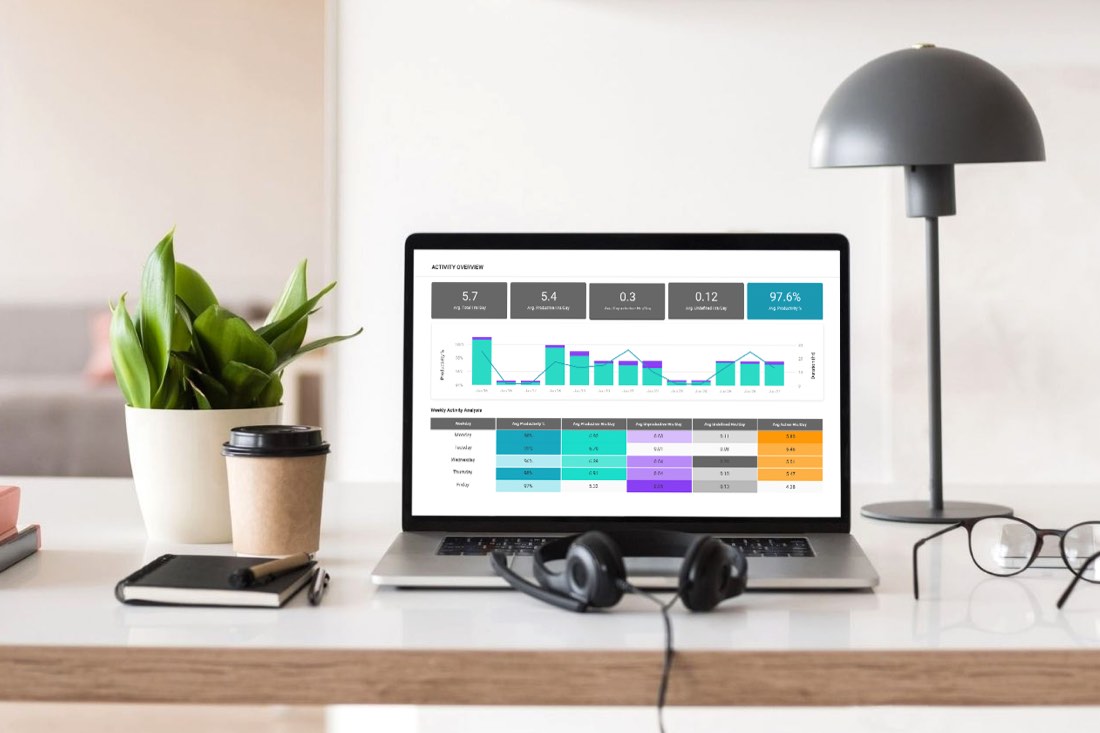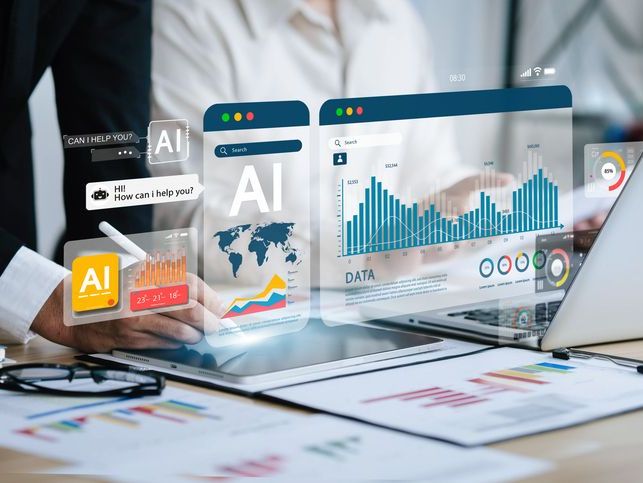People often associate employee monitoring with scary terms like “Big Brother” or “invasive surveillance” due to bad actors who give workplace monitoring tools a sordid reputation. But monitoring employees’ activity, when done correctly and for the right reasons, increases productivity, autonomy and trust in the workplace, whether for remote employees or in-office workers.
Want to make sure you’re approaching it the right way? Keep reading for insights on how to transform your organization’s workplace monitoring into insightful data tracking to improve employee productivity.
Understanding employee monitoring: What it entails
Contrary to some reports, modern employee monitoring isn’t (or shouldn’t be) about tracking an employee’s every move (or even heart rate). Most companies already use passive, manual monitoring methods like tracking work hours, task logging or office attendance.
However, today’s digital employee monitoring tools offer more proactive insights into how employees work, such as gathering data through digital activity tracking, app usage and productivity benchmarks, while remaining non-invasive and safeguarding privacy.
Modern business leaders understand employee trust and accountability drive better performance than micromanagement or obsessive surveillance. It’s why so many trade outdated, invasive monitoring tools for data-driven, productivity-focused platforms like ActivTrak. Successful employee monitoring drives mutual trust through transparency and employee consent — both core components of ethical monitoring.
The impact of employee monitoring on employee morale
One of the serious cons of employee monitoring is how it affects employee morale and well-being, especially when implemented poorly. According to the American Psychological Association, 56% of employees who are monitored at work say they typically feel stressed out about it. As Raconteur reports, almost two-thirds of workers view employee activity tracking software as a valid reason to quit a job. Some employees will go to great lengths to avoid monitoring by finding workarounds through private browsing or outside apps, which often puts company and customer data at risk. Going about monitoring the wrong way erodes trust, increases micromanagement and makes employees feel violated.
But when employers prioritize transparency and ethical monitoring policies, productivity tracking tools positively impact morale, well-being and productivity. When implemented and used correctly, employee monitoring helps leaders identify areas where employees need additional training or support rather than finding reasons to slap them on the wrists.
Understanding these metrics gives managers insight into when employees are at risk of burnout due to overwork or other issues, allowing them to provide further support. This leads to improved job performance and job satisfaction by bolstering trust, engagement and transparency between employees and management. Monitoring also protects employees, employers and clients by preventing unethical or illegal behavior in the workplace and safeguarding sensitive information.
The link between employee monitoring and productivity
Focusing on leveraging data from employee monitoring software to manage productivity — rather than using it to enforce draconian rules around time tracking — creates benefits for employers and employees. Digital employee monitoring provides visibility into how, when and where employees focus their time. This insight empowers managers to make data-informed decisions that impact performance.
On the other hand, when employers use surveillance to track employees’ every move, it puts people on edge. Instead of enhancing the factors that improve productivity — like employee engagement, job satisfaction and trust — these methods often backfire and keep employees from performing their best. Intrusive video surveillance, keystroke logging and access card monitoring make employees feel like they’re under a microscope. Even worse, they don’t reveal any information about actual productivity or performance. They just show when employees are physically present.
How employee monitoring increases productivity
Data-based productivity monitoring directly impacts performance by giving managers and employees insight into objective metrics. Rather than manually calculating productivity, digital means provide more accurate data and deeper insights. Tracking productivity KPIs such as task completion rates, quality of work and team efficiency gives employers a baseline to find and fix issues for individuals, teams and entire departments. Removing barriers to productivity leads to better focus time, less context switching and better alignment with organizational and individual goals.
Leveraging the right monitoring software empowers teams to:
- Identify and fix workflow inefficiencies and bottlenecks.
- Uncover peak productivity hours to create policies around meetings or focus hours.
- Reveal location insights to bolster remote work or hybrid policies.
- Find and mitigate distractions, whether online or in the office.
- Identify overworked employees to balance workloads and prevent burnout.
- Spot underutilized employees to provide more opportunities
- Uncover unused or improperly used apps to increase training or consolidate tech stacks.
Benefits for managers and teams
Both managers and teams see benefits from employee monitoring by removing guesswork and empowering smarter management. For example, managers with productivity monitoring data improve team visibility, reducing their need to micromanage while allowing them to provide laser-focused coaching for individual employees. Spotting workflow issues, distractions or overwork in real time empowers managers to intervene proactively, balance workloads and provide support. Improved productivity also means benefits to the organization, like higher profits, lower employee stress and better customer service.
Misconceptions of employee monitoring and productivity
Employee monitoring myths abound, often due to horror stories of invasive surveillance or illegal monitoring by companies implementing software for all the wrong reasons. Despite the bad press, employee monitoring is not about invading privacy, policing bad employees or spying on remote workers. And it’s not only for management’s benefit. Instead, successful employee monitoring focuses on support rather than surveillance. And good monitoring programs champion transparency and employee consent.
The best business leaders today understand productivity does not mean “constant activity.” Instead of using monitoring methods to catch people in the act of wasting time, the top managers use productivity monitoring to remove barriers to efficiency, performance and productivity.
How to effectively implement an employee monitoring program
If you’re considering implementing an employee monitoring program in your workplace, these best practices help ensure success.
Establish and communicate clear monitoring policies
Managers need to understand why employee activity monitoring matters and how they’re supposed to use the data. Employees also need to know what will be monitored and how it impacts their daily work. Defining, documenting and enforcing monitoring policies also ensures your organization is following any legal requirements around consent, privacy and data security.
Set clear productivity KPIs and goals
Ensure your employee monitoring activities contribute to improved productivity by describing what success looks like for individuals and teams. Define what questions your monitoring activities answer, like:
- What tools help employees accomplish work and what tools get in the way?
- Do company meetings detract from employee productivity or performance?
- Are some employees overworked and need more support or training?
- Which employees may need more challenges in their daily work activities?
- Are employees following compliance requirements and regulations?
This will guide your monitoring program, allowing you to collect the data that matters and leads to better decisions.
Communicate monitoring benefits with employees
When employees clearly see the benefits of monitoring on productivity, development and well-being, they’re less likely to feel violated and stressed out by it. Leverage tools like ActivTrak’s personal productivity dashboards to show employees data on how their productivity stacks up and how their performance contributes to company goals. This also empowers employees to take charge of their development within the company and increases trust among team members.
Use the right monitoring tools for your organization
Every organization has different goals, and some industries require different types of monitoring than others. Finding the right monitoring tool for your organization’s needs is imperative for a successful program. Ensure your tool of choice integrates with your tech stack, tracks the right activity, gives you actionable insights into your data and provides your team with features to intervene as necessary, like website or app blocking.
Final verdict: Does employee monitoring increase productivity?
Employee monitoring absolutely increases productivity in the workplace, when implemented properly and leveraged effectively. Intention, transparency and the right tools are key to a successful employee monitoring program. By focusing on productivity metrics and how to support employees rather than on surveillance to spy on workers, employers instill trust, increase engagement and boost productivity.
Check out a demo of our solutions to see how ActivTrak helps you strike the right balance between employee monitoring and privacy for your organization.





